FRIDAY, Jan. 7, 2022 (HealthDay News) — It is the ultimate irony: More COVID-19 treatments exist now than at any other time during the pandemic, but the skyrocketing number of cases from the surging Omicron variant might mean you can’t get them when you need them most.
Doctors and health systems are again in the difficult position again of rationing supplies to meet the needs of those in the most dire situations, the New York Times reported.
Adding to the dilemma is that not all the infusions and pills meant to treat people with COVID even work well against the Omicron variant.
“There is simply not enough to meet the needs of everyone who is going to have COVID in the upcoming weeks and be at risk of severe complications,” Dr. Natasha Bagdasarian, Michigan’s chief medical executive, told the Times. “I don’t think there is a way to make sure it gets to all the right people right now.”
To deal with supply shortages, health care providers are developing algorithms to determine who gets treatment. Some providers are left with only a few dozen treatment courses for the patients yet to come through their door. Some are giving some patients vitamins instead of the authorized drugs.
Among those being declined the treatments are those who are at high risk of complications but who have been vaccinated, the Times reported.
While unvaccinated people are at greater risk of hospitalization and death than those who have been vaccinated, that makes people feel “like you are rewarding intransigence,” Dr. Matthew K. Wynia told the Times. He is director of the Center for Bioethics and Humanities at the University of Colorado and has advised the state on how to ration COVID treatments.
Employees are rushing to develop algorithms to help them ration their supplies with patients, while also dealing with staffing shortages, Dr. Kelly Gebo, an infectious diseases and epidemiology specialist at Johns Hopkins University, told the Times.
“It’s demoralizing as health care workers when we can’t deliver optimal care when we have limited resources,” Gebo said.
The situation is reminiscent of the early part of the pandemic, when personal protective equipment and ventilators were scarce.
“It makes me nauseous going home at night because it makes me feel like I’m deciding, with this limited resource, who should get it,” Dr. Christian Ramers, an infectious disease specialist at Family Health Centers of San Diego, a network of clinics for low-income patients, told the newspaper.
Ramers’ clinics have had to turn away most — about 90% — of the hundreds of people who call every day seeking COVID treatments they’re eligible to get, he added.
“It is devastating to tell these patients, ‘Sorry, we can’t do anything for you, we have to save this drug only for our most severely immunocompromised,'” Erin McCreary, an infectious diseases pharmacist at the University of Pittsburgh Medical Center, told the Times.
Monoclonal antibodies, which are administered intravenously, have been the primary treatment for newly infected patients. The two most common types, however, don’t appear to keep Omicron at bay.
The one monoclonal antibody that is effective against Omicron, made by GlaxoSmithKline and Vir Biotechnology, is in limited supply. The federal government has ordered only about 450,000 treatment courses, the Times reported. The United States did not immediately order supplies of that treatment when it was authorized last May because it already had a large supply of other antibody treatments.
Meanwhile, Paxlovid is a new, powerful antiviral pill from Pfizer that the U.S. Food and Drug Administration authorized two weeks ago. But supplies of that drug are also scarce. Supplies of Paxlovid won’t be plentiful until April, even though the Biden administration doubled its order this week. Large quantities of the treatment are only now becoming available because it takes eight months to produce the pills, the Times reported.
The focus of some providers now is to use those limited medications to help people who have weakened immune systems or who are unvaccinated.
Patrick Creighton, 48, a sports radio host in Katy, Texas, came down with COVID over the holidays and managed to get some Paxlovid pills, but it took him two telehealth visits and 19 calls to pharmacies before he had them in hand.
“It should be easily obtainable for everybody,” Creighton told the Times.
More information
The U.S. Centers for Disease Control and Prevention has more on COVID-19.
SOURCE: New York Times
Copyright © 2025 HealthDay. All rights reserved.

